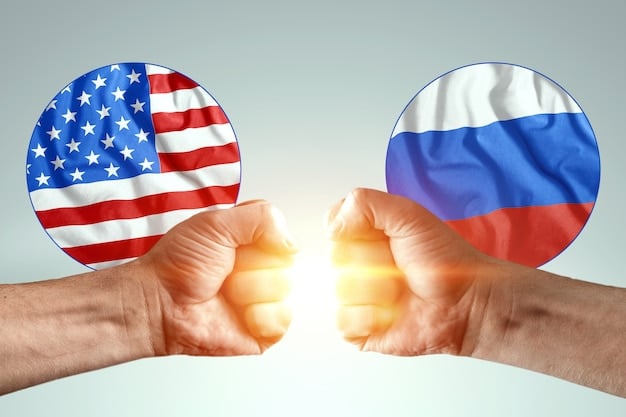US-Russia Relations: Latest Developments & Global Security Impact

Recent developments in US-Russia relations involve ongoing tensions over geopolitical issues, including conflicts in Ukraine and Syria, arms control treaties, and alleged interference in democratic processes, impacting global security through shifting alliances and potential for escalated conflict.
The relationship between the United States and Russia is a complex tapestry woven with threads of cooperation, competition, and conflict. Understanding what are the latest developments in the US-Russia relations and their implications for global security requires a nuanced analysis of recent events and historical context to grasp the potential impact on the international stage.
Understanding Current US-Russia Relations
The dynamics between the U.S. and Russia are a critical component of global stability. This relationship, shaped by historical events and contemporary geopolitical interests, influences various aspects of international relations. Understanding the current state of affairs involves examining specific areas of cooperation and contention.
Historical Context Shaping Modern Relations
The collapse of the Soviet Union significantly altered the global landscape. The end of the Cold War ushered in a period of complex interactions between the U.S. and Russia. Understanding this historical backdrop is essential to grasp the nuances of their present relationship.
- The dissolution of the Warsaw Pact and the expansion of NATO eastward were key developments that shaped Russia’s perception of its security environment.
- Economic reforms in Russia during the 1990s, influenced by Western advisors, had profound and lasting impacts on its socio-political structure.
- Cooperation on counter-terrorism efforts following the 9/11 attacks demonstrated a potential for collaboration despite underlying tensions.
Areas of Current Cooperation and Contention
Despite numerous disagreements, the U.S. and Russia find themselves cooperating in certain areas. However, significant points of contention continue to fuel discord. Understanding these areas is crucial for assessing the overall health of the relationship.
Current issues contributing to problems between the countries include military exercises and growing hostility.

Recent Diplomatic Engagements and Communications
Diplomatic engagements and communications are essential for managing the complex relationship between the U.S. and Russia; these interactions serve as channels for dialogue, negotiation, and de-escalation, especially during periods of tension. Monitoring these engagements provides insights into the evolving dynamics between the two nations.
High-Level Meetings and Summits
High-level meetings and summits between U.S. and Russian leaders are pivotal events as they provide opportunities for direct dialogue and strategic discussions. These meetings often set the tone for bilateral relations and address critical issues.
- Agreements reached during summits can lead to breakthroughs in arms control, trade, or other areas of mutual interest.
- Even without concrete agreements, these meetings can serve as confidence-building measures by fostering better understanding and communication.
- The tone and outcomes of these summits reflect the current state of relations and signal future directions.
Communication Channels and Protocols
Maintaining open and reliable communication channels is vital for preventing misunderstandings and managing crises. Established protocols ensure messages are accurately conveyed and received.
The ability for open and honest lines of communication is vital for preventing missteps.
Military Posturing and Strategic Alliances
Military posturing and strategic alliances significantly influence the security landscape, particularly in the context of US-Russia relations. These actions signal intentions, project power, and shape regional and global dynamics. Analyzing this activity is extremely important.

NATO Expansion and Russian Concerns
NATO expansion remains a sensitive issue in US-Russia relations. Russia views NATO’s eastward expansion as an encroachment on its sphere of influence. They see it as undermining its security interests. It is important to explore how the growing NATO expansion affects each country.
- Russia perceives NATO’s military infrastructure near its borders as a direct threat, increasing its sense of vulnerability.
- NATO argues that its expansion is a defensive measure to protect new members from potential Russian aggression.
- Differing interpretations of NATO’s purpose and intentions fuel mistrust and contribute to heightened tensions.
Arms Control Treaties and Nuclear Disarmament
Arms control treaties and nuclear disarmament efforts are crucial for maintaining strategic stability. Agreements such as the New START treaty limit the development and deployment of nuclear weapons reducing the risk of large-scale conflict.
Geopolitical Flashpoints: Ukraine and Syria
Geopolitical flashpoints, such as Ukraine and Syria, serve as critical arenas where US-Russia relations are tested. These regions highlight the divergent interests and strategic objectives of both countries, often leading to increased tensions and proxy conflicts.
The Conflict in Ukraine
The conflict in Ukraine is a major point of contention. Russia’s annexation of Crimea in 2014 and its support for separatists in eastern Ukraine have led to international condemnation and sanctions.
- The U.S. and its allies have provided military and financial assistance to Ukraine, reinforcing its ability to defend its sovereignty.
- Russia views Ukraine as a buffer zone and opposes its alignment with Western institutions.
- The ongoing conflict has resulted in significant humanitarian consequences, including displacement and loss of life.
The Syrian Civil War
The Syrian civil war has further complicated US-Russia relations. Both countries have supported opposing sides, leading to a complex and volatile situation. It’s important to explore different aspects of the civil war; the different sides and how it impacts surrounding countries.
Economic Sanctions and Trade Relations
Economic sanctions and trade relations play a significant role in shaping the dynamics between the U.S. and Russia. Economic measures affect political relations; these actions serve as tools of coercion and influence, impacting economic ties and broader geopolitical strategies.
Impact of Sanctions on the Russian Economy
Sanctions imposed by the U.S. and its allies have had a notable impact on the Russian economy. They have limited access to international capital, restricted technology transfers, and targeted key sectors.
- Reduced foreign investment and limited access to advanced technologies have hindered Russia’s economic modernization efforts.
- Sanctions have contributed to economic instability, currency depreciation, and inflationary pressures.
- Russia has sought to mitigate the impact of sanctions by diversifying its economic partnerships and promoting import substitution policies.
Trade Relations and Energy Exports
Trade relations, particularly in the energy sector, are vital to the Russian economy. Russia is a major exporter of oil and natural gas, and energy revenues are important to its budget.
Cyber Warfare and Information Security
Cyber warfare and information security have emerged as critical dimensions of US-Russia relations. These domains serve as battlegrounds for espionage, sabotage, and influence operations, posing significant challenges to national security and international stability.
Allegations of Election Interference
Allegations of Russian interference in U.S. elections have strained US-Russia relations. U.S. intelligence agencies have concluded that Russia conducted cyber operations to influence the 2016 and 2020 presidential elections.
- These allegations have led to investigations, sanctions, and heightened scrutiny of Russian activities in the digital realm.
- Russia denies interfering in U.S. elections, dismissing the allegations as politically motivated.
- The controversy has fueled mistrust and damaged diplomatic relations between the two countries.
Cyber Espionage and Infrastructure Attacks
Cyber espionage and infrastructure attacks between the U.S. and Russia are ongoing concerns. Both countries possess advanced cyber capabilities that can be used for espionage, sabotage, and disruption.
| Key Point | Brief Description |
|---|---|
| 🌍 Geopolitical Tensions | Ongoing disputes in Ukraine, Syria, and NATO expansion. |
| 🛡️ Military Posturing | Increased military exercises and strategic alliances. |
| 💻 Cyber Warfare | Allegations of election interference and cyber attacks. |
| 💸 Economic Sanctions | Restrictions impacting Russia’s economy and trade relations. |
Frequently Asked Questions
▼
The main areas of disagreement include geopolitical issues such as conflicts in Ukraine and Syria, NATO expansion, arms control, alleged election interference, and cyber warfare.
▼
Economic sanctions have limited Russia’s access to international capital and technology, contributing to economic instability, currency depreciation, and inflationary pressures to some degree.
▼
NATO expansion is a contentious issue, with Russia viewing it as a threat to its security interests. NATO’s military presence near Russia’s borders results in heightened tensions.
▼
Arms control treaties, such as New START, are crucial for maintaining strategic stability. Efforts to limit the development and deployment of nuclear weapons continue to be relevant to this day.
▼
Cyber warfare has emerged as a critical dimension of US-Russia relations, with allegations of election interference, cyber espionage, and critical infrastructure attacks.
Conclusion
Understanding the latest developments in US-Russia relations and their implications for global security requires awareness of the involved historical context. It requires keen awareness of military activity in order to have a full scope of the future of our global landscape.





